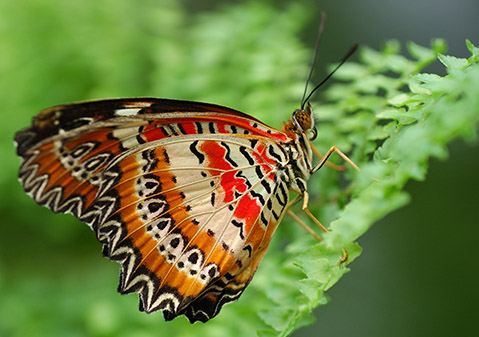Of Moths, Butterflies, and Cap’n Crunch
What’s the Difference Between These Winged Creatures?

The other morning, I walked into my bathroom, and on the vanity next to the sink was a moth the size of a small Buick. Okay, not that big, but, well, for a moth it was pretty darn big.
I left it undisturbed but kept a wary eye on it as I stuck my head under the faucet to get ready for work. As I toweled off my noggin, my guest raised up its wings and began to vibrate. I decided to finish drying off in the other room in order to give the thing some privacy.
Being of a curious nature, especially regarding all things that crawl, fly, or slither, I began to wonder, “What’s the difference between a moth and a butterfly, anyway?” I always figured that moths liked to eat your sweaters and butterflies were lovely to look at. I finished slurping up the yellow-orange milk that remained long after my Cap’n Crunch had left the bowl and went to Google my moth-versus-butterfly question. I also wondered if that suspicious, radioactive carrot-y color in my cereal bowl ever actually occurs in nature. I would Google that another time.
Some online detective work helped me to determine that the bug on my bathroom sink was probably Manduca quinquemaculata, or, rather, the flying adult moth version of the tomato hornworm. It’s also known as a hummingbird or hawk moth.
And, I discovered that although there are similarities between moths and butterflies, there are also differences. And to make matters a little confusing, there are also exceptions.
Both moths and butterflies belong to the scientific order Lepidoptera, which means “scale-winged,” referring to the powdery scales that come off on your fingers when you handle one of these creatures. Similarly, moths and butterflies both begin their lives as caterpillars before morphing into the adult, winged versions of themselves.
As for the differences (and remember, there are exceptions), here are a few:
• Butterflies are generally larger and are available in fashion colors, while moths are smaller and usually come in drab shades of brown or beige.
• A butterfly’s antennae are club-shaped with a long shaft and a bulb at the end. A moth’s are feathery or saw-edged.
• Butterflies are diurnal, meaning they fly around during the day. Since moths are nocturnal, they like to run suicide missions into your lightbulbs, lit candles, and your computer screen, especially when you’re watching a horror movie on Netflix.
• Butterflies fold their wings vertically over their backs, while moths hold their wings in a tent-like fashion.
• A butterfly changes over from a caterpillar inside of a hard, smooth chrysalis. Moths spin a silk-like cocoon.
But because my space is limited and there’s lots more to know about these flying wonders (including those exceptions), I suggest you get out your magnifying glass and your computer, as I did, and look further.
Incidentally, I discovered that there are vast amounts written about Cap’n Crunch. Oh, and the color? Yellow dye #5 and yellow dye #6. Perfectly natural.



